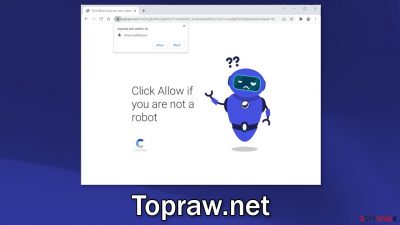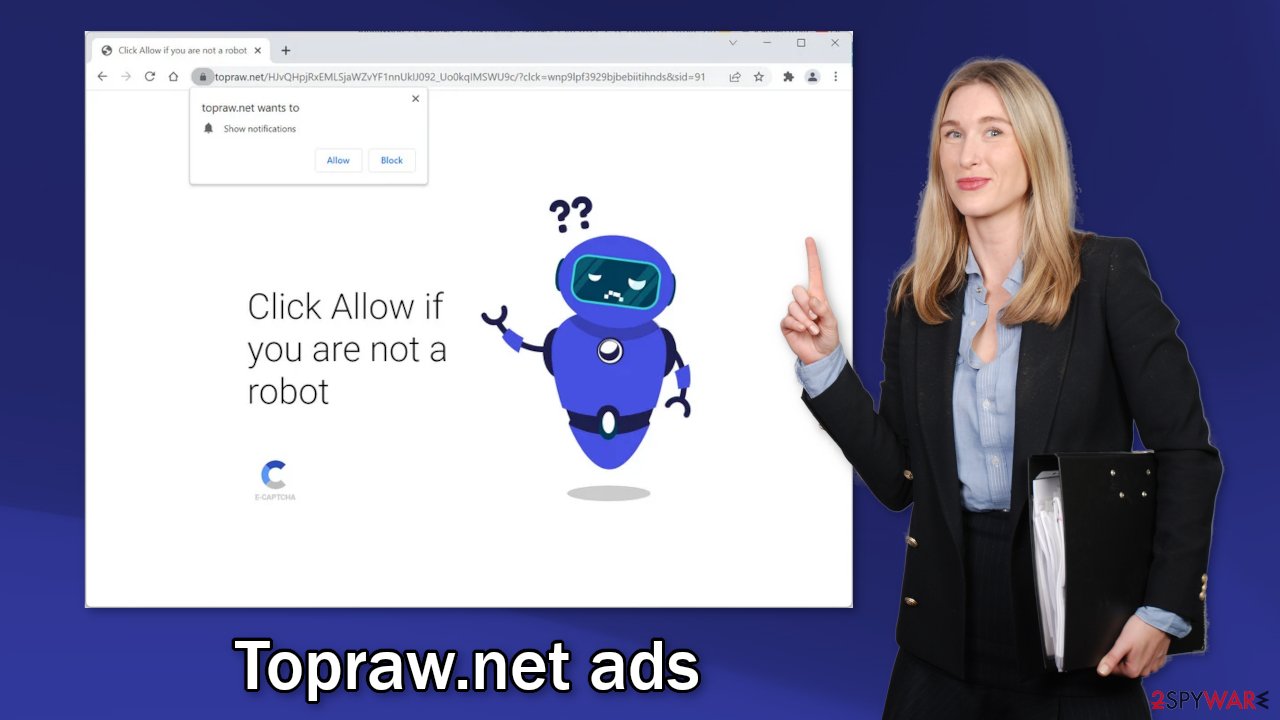Topraw.net ads (spam) - Free Guide
Topraw.net ads Removal Guide
What is Topraw.net ads?
Topraw.net is disguised as a human verification step to get users to click the “Allow” button

Topraw.net is a bogus website that uses social engineering to get users to subscribe to push notifications. It displays a fake message that urges users to click the “Allow” button which grants the page permission to spam users with annoying pop-up ads. Sadly, the developers of the site do not care about user privacy and security.
As a result, people can start receiving ads with links leading to dangerous websites that try to trick people into downloading PUPs (potentially unwanted programs), and malware.[1] These can be various online scams, fake antivirus warnings, free software deals, and so on.
In recent years, we have seen a rise in push notification spam pages. We previously wrote about Ufyhzk.com, Gloonseetaih.com, and Downloadit-on.com, which use very similar techniques. The reason behind their appearance is that the creators of such sites can make quite a substantial amount of money if they distribute them right. They get paid with the help of pay-per-click advertising.[2]
| NAME | Topraw.net |
| TYPE | Push notification spam; adware |
| SYMPTOMS | Pop-up ads start appearing in the corner of the screen after the “Allow” button is pressed |
| DISTRIBUTION | Shady websites, deceptive ads, redirects, freeware installations |
| DANGERS | Links embedded in the push notifications can lead to dangerous websites where users can be tricked into providing their personal information and suffer from monetary losses |
| ELIMINATION | Users can block push notifications via browser settings |
| FURTHER STEPS | It is recommended to use a repair tool like FortectIntego after the removal to fix any remaining damage |
Distribution methods
It is rare for people to find pages like Topraw.net in search results. Most of the time people get redirected from other already shady websites. For example, pages that engage in illegal activities are full of deceptive ads and sneaky redirects and it is easy to end up in the wrong place if you click on random things.
The scheme usually works when people do not realize they were taken to a different page that is completely unrelated to the one they were on previously. When users see this message, most of the time they think they need to complete the human verification to be able to view content they were looking for:
Click Allow if you are not a robot
If you see this or similar messages, they are most likely fake because this is not how captcha verification looks like. Real captcha verifications usually ask users to identify certain objects in pictures, like crosswalks, bikes, or simply check a box. A legitimate website should never ask you to allow push notifications for something in return.

However, such pages can also appear not only because of users' fault. Sometimes people infect themselves with adware that causes pop-ups, banners, and redirects that lead to these spam pages. This happens when people download applications from pages that engage in software bundling.
Block notifications in the settings
Push notifications can be blocked only manually in the browser settings. You should also clear cookies and cache to delete any information that suspicious pages could have collected about you. That includes your IP address, geolocation, links you click on, and things you purchase online.
Using a maintenance tool like FortectIntego makes this step really easy. It can automatically stop the tracking and get rid of the junk files that could be causing performance issues. This software can also fix various system errors, corrupted files, and registry issues which is especially helpful after a virus infection. Otherwise, proceed with the guide below:
Google Chrome (desktop):
- Open Google Chrome browser and go to Menu > Settings.
- Scroll down and click on Advanced.
- Locate the Privacy and security section and pick Site Settings > Notifications.
![Stop notifications on Chrome PC 1 Stop notifications on Chrome PC 1]()
- Look at the Allow section and look for a suspicious URL.
- Click the three vertical dots next to it and pick Block. This should remove unwanted notifications from Google Chrome.
![Stop notifications on Chrome PC 2 Stop notifications on Chrome PC 2]()
Google Chrome (Android):
- Open Google Chrome and tap on Settings (three vertical dots).
- Select Notifications.
- Scroll down to Sites section.
- Locate the unwanted URL and toggle the button to the left (Off setting).
![Stop notifications on Chrome Android Stop notifications on Chrome Android]()
Mozilla Firefox:
- Open Mozilla Firefox and go to Menu > Options.
- Click on Privacy & Security section.
- Under Permissions, you should be able to see Notifications. Click Settings button next to it.
![Stop notifications on Mozilla Firefox 1 Stop notifications on Mozilla Firefox 1]()
- In the Settings – Notification Permissions window, click on the drop-down menu by the URL in question.
- Select Block and then click on Save Changes. This should remove unwanted notifications from Mozilla Firefox.
![Stop notifications on Mozilla Firefox 2 Stop notifications on Mozilla Firefox 2]()
Safari:
- Click on Safari > Preferences…
- Go to Websites tab and, under General, select Notifications.
- Select the web address in question, click the drop-down menu and select Deny.
![Stop notifications on Safari Stop notifications on Safari]()
MS Edge:
- Open Microsoft Edge, and click the Settings and more button (three horizontal dots) at the top-right of the window.
- Select Settings and then go to Advanced.
- Under Website permissions, pick Manage permissions and select the URL in question.
- Toggle the switch to the left to turn notifications off on Microsoft Edge.
![Stop notifications on Edge 2 Stop notifications on Edge 2]()
MS Edge (Chromium):
- Open Microsoft Edge, and go to Settings.
- Select Site permissions.
- Go to Notifications on the right.
- Under Allow, you will find the unwanted entry.
- Click on More actions and select Block.
![Stop notifications on Edge Chromium Stop notifications on Edge Chromium]()
Additional measures
In some cases, push notifications can be a sign of a more serious problem, which is adware. You might have been redirected to this page by a program that is hiding in your system. If you recently installed freeware,[3] it is very likely.
You could have downloaded the program because it was disguised as a very “handy” tool, or it was included as bundled software, which means you did not even know about it. Unofficial sites distributing freeware are the main source behind this problem. They usually do not disclose the information about bundled software clearly on the site which leads to many people infecting themselves without even knowing.
It is best to always choose the “Custom” or “Advanced” installation method and read the Privacy Policy, Terms of Use. Even though it might take a long time, you can find out what the application will be able to perform on your machine and what data it will collect. The most important step is to check the list of the files. If you see any additional programs, just untick the boxes next to their names.
On the other hand, when a PUP is already in your system, it can be hard to locate it. It is unknown which particular program could be causing the unwanted behavior. It could be disguised as an antivirus, system optimizer, media player, etc. We always suggest our readers deploy anti-malware tools like SpyHunter 5Combo Cleaner or Malwarebytes that can scan the system automatically, detect suspicious processes in the machine and fully eliminate them.
If you know which program is responsible, you can use our instructions for Windows and Mac machines. Make sure to delete every related file and folder as well.
Windows 10/8:
- Enter Control Panel into Windows search box and hit Enter or click on the search result.
- Under Programs, select Uninstall a program.
![Uninstall from Windows 1 Uninstall from Windows 1]()
- From the list, find the entry of the suspicious program.
- Right-click on the application and select Uninstall.
- If User Account Control shows up, click Yes.
- Wait till uninstallation process is complete and click OK.
![Uninstall from Windows 2 Uninstall from Windows 2]()
Windows 7/XP:
- Click on Windows Start > Control Panel located on the right pane (if you are Windows XP user, click on Add/Remove Programs).
- In Control Panel, select Programs > Uninstall a program.
![Uninstall from Windows 7/XP Uninstall from Windows 7/XP]()
- Pick the unwanted application by clicking on it once.
- At the top, click Uninstall/Change.
- In the confirmation prompt, pick Yes.
- Click OK once the removal process is finished.
Mac:
- From the menu bar, select Go > Applications.
- In the Applications folder, look for all related entries.
- Click on the app and drag it to Trash (or right-click and pick Move to Trash)
![Uninstall from Mac 1 Uninstall from Mac 1]()
To fully remove an unwanted app, you need to access Application Support, LaunchAgents, and LaunchDaemons folders and delete relevant files:
- Select Go > Go to Folder.
- Enter /Library/Application Support and click Go or press Enter.
- In the Application Support folder, look for any dubious entries and then delete them.
- Now enter /Library/LaunchAgents and /Library/LaunchDaemons folders the same way and terminate all the related .plist files.
![Uninstall from Mac 2 Uninstall from Mac 2]()
How to prevent from getting adware
Access your website securely from any location
When you work on the domain, site, blog, or different project that requires constant management, content creation, or coding, you may need to connect to the server and content management service more often. The best solution for creating a tighter network could be a dedicated/fixed IP address.
If you make your IP address static and set to your device, you can connect to the CMS from any location and do not create any additional issues for the server or network manager that needs to monitor connections and activities. VPN software providers like Private Internet Access can help you with such settings and offer the option to control the online reputation and manage projects easily from any part of the world.
Recover files after data-affecting malware attacks
While much of the data can be accidentally deleted due to various reasons, malware is one of the main culprits that can cause loss of pictures, documents, videos, and other important files. More serious malware infections lead to significant data loss when your documents, system files, and images get encrypted. In particular, ransomware is is a type of malware that focuses on such functions, so your files become useless without an ability to access them.
Even though there is little to no possibility to recover after file-locking threats, some applications have features for data recovery in the system. In some cases, Data Recovery Pro can also help to recover at least some portion of your data after data-locking virus infection or general cyber infection.
- ^ What Is Malware?. Cisco. Cybersecurity Blog.
- ^ What Is PPC? Learn the Basics of Pay-Per-Click (PPC) Marketing. WordStream. Advertising Solutions.
- ^ Freeware. Wikipedia. The free encyclopedia.













